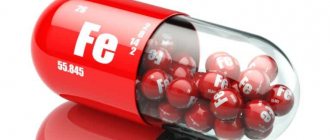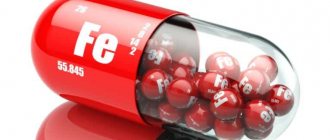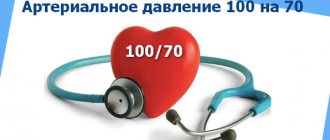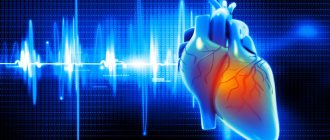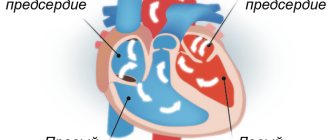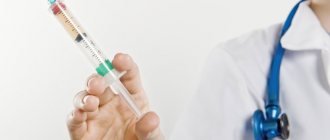- Causes
- Pathologies
- Diagnostics
- Treatment
- Our doctors
If your heart is beating fast, it is normal to feel it. In cases where the condition is caused by physiological factors, the state of health returns to normal on its own, without visiting a doctor.
Every person has experienced heart palpitations at one time or another. This condition can be either normal or pathological. Only a doctor can determine the exact cause after an examination, but you can independently determine whether you should rush to a specialist or not to worry.
Causes of increased heart rate
When assessing a person’s condition, one must take into account the pulse: is it elevated or normal. If your heart is beating fast, it is normal to feel it. Physiological reasons for this condition:
- strong excitement;
- age up to 7 years;
- exercise stress;
- fright;
- poisoning;
- drinking coffee and other tonic drinks.
In cases where the condition is caused by physiological factors, the state of health returns to normal on its own, without visiting a doctor.
The feeling of palpitations is also characteristic of some pathologies. Most often this is associated with endocrine, vascular and neurological disorders. In this case, a comprehensive diagnosis is required to determine the cause.
More about the disease
In medicine, the term extrasystole usually means untimely contraction of the heart muscle or any of its parts. The phenomenon can be more simply explained by the word arrhythmia. You don't have to have heart problems to experience this type of arrhythmia. Factors such as addiction to bad habits, dehydration, stress, any poisoning, constant physical activity on the body, high doses of caffeine may well become the causative agent and cause of the development of arrhythmia. Some people are more susceptible to the disease than others. The list of those predisposed to the disease includes people suffering from neuroses, cervical osteochondrosis, and vegetative-vascular dystonia. For a long time, muscle dysfunction may not reveal itself and be recognized unexpectedly during an electrocardiogram.
If the disease is caused by pathologies of the heart muscle, along with a feeling of movement in the heart area, the following signs can be noticed:
- heart sinking;
- tremors inside the chest;
- tumbling and rolling over in the chest;
- heart or chest pain;
- dizziness;
- cardiac syncope;
- dyspnea;
- headache.
The listed accompanying phenomena indicate an organic cause of the disease. In the case of functional, the occurrence of sweating, suffocation, anxiety, and hot flashes is noted.
Pathologies in which the heart beats strongly
If there are no physiological reasons, but the heart is pounding, you need to look for pathology. Conditions in which symptoms are observed:
- pathologies of the cardiovascular system: infection, heart disease; arrhythmia, cardiosclerosis, hypertension, heart failure, pericarditis;
- endocrine diseases: diffuse toxic goiter, hyperthyroidism;
- cardiopsychoneurosis;
- anemia;
- menopausal syndrome;
- neurosis.
When the heart is beating strongly and a person experiences chest pain and fear of death, you should immediately call an ambulance. This could be an attack of angina. It is quickly relieved with nitroglycerin, but the patient requires examination and medical supervision.
Are heart failures dangerous?
Interruptions in the heart should be considered an alarming sign in the following cases:
- If the unpleasant sensations recur several times a week or bother you constantly.
- If the duration of attacks increases each time.
- If the irregularity of the heart is accompanied by severe pain, noticeable pallor, fainting or increasing shortness of breath.
It is also worth noting that the severity of the patient’s subjective feelings does not always reflect the severity of the disease. Often, severe and frequent interruptions in the functioning of the heart are the result of unpleasant but harmless diseases, such as autonomic dysfunction.
Really serious illnesses, for example, severe arrhythmias (flutter, atrial fibrillation, extrasystole) and myocardial infarction can only be detected by ECG. Therefore, the exact answer to the question of whether the described sensations in the heart are dangerous should be given by the doctor after a complete examination of the patient.
Diagnostics
If you have increased heartbeat, you should consult a therapist. He will refer you for an examination, with the results of which the patient will go to a specialist: a cardiologist, endocrinologist or neurologist. The list of diagnostic measures if the heart is beating strongly includes:
- general blood analysis;
- ECG;
- blood test for thyroid hormones;
- Ultrasound of the heart (EchoCG);
- daily monitoring of pulse and heart activity according to Holter;
- Ultrasound of the thyroid gland.
If the disease cannot be detected by laboratory and instrumental methods, a consultation with a psychiatrist may be required.
Read also: Heartache
Video on the topic
Cardiologist about palpitations:
A rapid pulse is an unpleasant phenomenon that can quickly lead to the development of such dangerous ailments as tachycardia, arrhythmia, stroke and others. When the first symptoms of the disease appear, you need to take action immediately. Timely diagnosis can save you from many problems and ensure a quick recovery.
The information on the MyMedNews.ru website is for reference and general information, collected from publicly available sources and cannot serve as a basis for making a decision on the use of medications in the course of treatment.
MyMedNews.ru
And we also have
The pressure has increased to 130 over 90: what does this mean and what to do to stabilize the indicators?
Treatment of increased heart rate
Treatment tactics depend on the diagnosis. Treatment options:
- antiarrhythmic drugs are prescribed in the presence of cardiac arrhythmias;
- tranquilizers are required for neurosis;
- antibiotics are prescribed if there is a heart infection;
- nootropics and antispasmodics are needed for neurocirculatory dystonia;
- thyreostatics or radioactive iodine are indicated for thyrotoxicosis and hyperthyroidism;
- Hormone replacement therapy is carried out for menopausal syndrome;
- for anemia, treatment is prescribed taking into account its type: iron supplements, vitamin B12, etc.
If after 10–14 days of treatment a person does not feel better, further examination is carried out to determine the cause. Sometimes you just need to change the drug to a similar one due to the individual characteristics of the patient.
The feeling of palpitations can be considered normal in several cases. But if the condition recurs frequently and without provoking factors, you need to consult a doctor to find out the cause.
Dear patients! Remember that only a qualified doctor can make an accurate diagnosis, determine the causes and nature of the disease, and prescribe effective treatment. You can make an appointment with our specialists or call a doctor at home by calling 8-(4822)-33-00-33
Be healthy and happy!
Norms by age and methods of measurement at home
Pulse rate is an important indicator in assessing the performance of the heart muscle.
Its determination is considered the main component in detecting rapid heartbeat and other diseases, sometimes even very serious and threatening human health.
First you need to understand what it is. Pulse is the vibration of the walls of blood vessels that appears due to contractions of the heart muscles . This indicator makes it possible to evaluate not only the strength and rhythm of the heartbeat, but also the general condition of the arteries, veins and capillaries.
Pulse is measured by the number of pulse waves or beats. It is important to note that this indicator should in no case exceed the following values: from 59 to 90 at rest in adults. But in children, the heart rate is slightly different.
In a completely healthy person, the intervals between heartbeats should be completely identical. But uneven pulsation indicates the presence of serious malfunctions in the body.
The most likely reasons for this may be ailments related to the functionality of the heart, as well as other diseases, for example, such as problems with the performance of the endocrine system and its glands.
Pulse rates for children and adults:
- 0 - 1 month. Allowed values: 100 - 170;
- from 1 month to 1 year: 101 - 161;
- 1 - 2 years. From 92 to 154;
- 4 - 6 years: 85 - 125;
- 7 - 8 years: 77 - 119;
- 9 - 10 years: 67 - 107;
- 11 - 12 years: 59 - 99;
- 13 - 15 years: 54 - 96;
- adults under 50 years old: 59 - 79;
- 51 - 59 years: 64 - 84;
- 60 - 80 and more: 69 - 91.
You don't need any special skills or equipment to calculate your heart rate. Each person, if necessary, can carry out this procedure at home.
The heart rate determination process is as follows:
- First of all, you need to remove clothes, bracelets, watches and other accessories from your hands that may interfere with the procedure. It is important to note that during manipulation nothing should interfere with the passage of blood through the vessels;
- after this, you must thoroughly wash and dry your hands;
- some experts recommend carrying out the procedure in a lying position, since this is the only way a person can relax. And this will help to obtain the most reliable indicators;
- you need to prepare a stopwatch. It is advisable to count the pulse wave in a minute. If absolutely necessary, this time period can be reduced to 30 seconds. In this case, the resulting numbers are necessarily multiplied by two. If you reduce the time for determining the pulse to a quarter of a minute, you will have to multiply by four. It is important to remember that approximate calculations may not be accurate, especially in the presence of arrhythmia;
- To carry out the measurement, you need to press the human radial artery with three fingers. In this case, it is not recommended to use the thumb for the reason that a significant distortion of the results is possible due to the sensation of one’s own pulsation;
- immediately after the pulse has been detected, it is necessary to begin counting the contractions. If the heartbeat is rapid, the count should be carried out for one minute. When you feel normal, the pulse is determined within thirty or fifteen seconds. The resulting data is multiplied by two and four, respectively;
- the results obtained must be entered into the observation sheet;
- hands should be washed and dried again.
Is extrasystole normal or a threat to health?
Of course, today many people face a similar problem. So how dangerous can these disorders be? In fact, extraordinary contractions can and, in fact, occur at any age. For example, young people often complain of a feeling of a strong heartbeat, this is extrasystole. Moreover, according to statistics, about 80% of people over fifty years of age suffer from periodic “unscheduled” shocks from time to time.
What causes systole? With some disturbances in the functioning of the heart and blood vessels, the conduction system changes: so-called ectopic foci, areas of increased activity, are formed in it. Most often, such a disorder appears in the conduction tracts of the ventricles, atria, and atrioventricular node. It is these ectopic foci that generate impulses that trigger the contraction mechanism of the heart during its relaxation phase (diastole). This is what extrasystole looks like. This, by the way, can be extremely dangerous.
Of course, occasional impulses do not pose a serious threat to human health. Nevertheless, they signal the presence of a particular problem; experts recommend that such patients pay more attention to their lifestyle, monitor their diet and undergo regular examinations.
On the other hand, too frequent extrasystoles affect the functioning of the whole organism. Indeed, as a result of multiple extraordinary contractions, the release of blood decreases, which leads to a decrease in blood flow in the brain and coronary vessels. In such cases, cardiac extrasystole is extremely dangerous, as it can lead to myocardial damage, fainting, or even sudden death of a person.
Consequences of heart rhythm disturbances and prognosis for patients
Prognosis for patients directly depends on the course of the disease and the presence of concomitant disorders. For example, extrasystoles that develop against the background of a heart attack, cardiomyopathy and organic myocardial lesions are considered the most dangerous.
In any case, the lack of qualified and timely assistance can lead to a lot of complications. Despite the fact that in most cases, extrasystole is benign, sometimes other dangerous diseases develop against its background, including paroxysmal tachycardia, atrial fibrillation and atrial flutter. Such conditions can lead to sudden death of the patient.
There are some other complications that accompany extrasystole. These are, first of all, problems with blood circulation and tissue nutrition. Indeed, with repeated extrasystoles, the volume of blood ejected by the heart decreases significantly. This leads to oxygen starvation and disruption of normal blood circulation. Often, extrasystole leads to the development of chronic insufficiency of the renal, coronary and cerebral vessels, which entails even greater complications.


